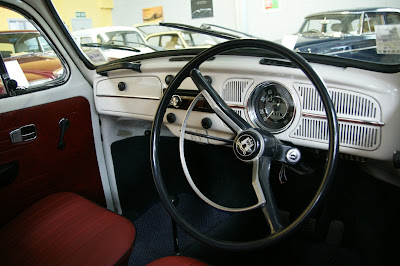 |
| 1966 VW 1300, Hobson St, Thorndon |
Most of the many VWs that graced New Zealand roads were imported kitsets constructed at a factory in Otahuhu in Auckland:*
Auckland businessman and car-maker Arthur Turner obtained the Volkswagen franchise in 1953, replacing a failed Jowett deal, and the first Beetles rolled out of his Otahuhu plant in April 1954. They proved popular with Kiwis, and the air-cooled 'Veedub' with its characteristic off-beat roar became a common sight on New Zealand roads. The ten-thousandth Beetle rolled out of the Otahuhu assembly plant in May 1962.
The original design was steadily improved and updated over the years. The earliest 'single piper' models gave way to two exhaust pipes. The rear window grew from a small oval to a reasonably practical frame. Engine sizes rose from the modest 1200 cc to 1300, 1500 and eventually 1600 cc. All betrayed their origins as aero engines, with flat performance in some rev-ranges, but they also gave the Beetle better performance than many small British cars of the period.
- Matthew Wright, New Zealand on the Move, Auckland, 2011, p.143.* The Otahuhu factory also assembled Fiat Bambinas and VW Kombis.
Grandad's tan-ochre VW served for around 20 years of reliable motoring, helped by the specialist German car mechanics at Qualitat down in Penrose. In the end it would have kept going for another few years, but it was stolen about 1990, stripped for parts, and dumped.
My mother's series of VWs, which were only coincidentally built in the same year, had a little more adventurous lives. Two were stolen, including one parked outside the house next to Jellicoe Park, which was never seen again, and another that had been parked in Kitchener St in town on a Friday night and was later found nearby parked on a double-yellow line and impounded: the thieves hadn't managed to get it started. Which begs the question, how did it get driven to town and home from the car pound? Magic, clearly. Another one kept going after the battery actually dropped out of the engine cavity while it was going over the Harbour Bridge. Which is probably the textbook definition of indestructability, when you think of it.
Of course, they weren't perfect cars - far from it. The electrics were notoriously poor, particularly on the earlier 6-volt batteries. I am reliably informed that if you turned on too many of the lights, radio and wipers at once, the car would stop dead. (This was later rectified by installing 12-volt batteries). The heavy body combined with a modest engine output meant that the VW could never attain particularly swift speeds, even on the motorway - the top reaches of the dial (80-90mph, from memory) were dreamland territory. But at least the rear-mounted engine could deliver a surprising kick from a red light stop, outdistancing many other cars for at least the first 50 metres after an intersection, by which time all opposing cars would sail past again.
I don't recall the heater ever working in our VWs, or at least we never bothered with it. The windscreen wipers couldn't really keep up with a proper Auckland downpour, and indeed I recall one such deluge coinciding with my passenger-side window mysteriously dropping down into the door cavity, meaning I was soaked on a long drive home.
That said, the VW was a great car, the sort of unpretentious utilitarian everyman / everywoman vehicle that transcended social class. The throaty engine noise referred to above was great, because it meant I could hear whenever Grandad or my mother was nearly home. The seatbelts were tipped with shiny, solid 'A'-shaped heads that a hefty metallic clunk to them, but of course I never used them when I was young, because this was the 1970s and there were no car-seats. (The seatbelts would've been useless in a crash if I'd been wearing them anyway). I've been told I used to enjoy travelling on the motorway standing on the passenger seat pretending to 'drive' using the handle above the glove-box as my steering wheel, and when I was younger my preferred nook was the 'canoe seat' storage area behind the back seat, because it was nice and warm from the hot engine below.
We managed fairly impressive journeys in the VWs now and then, but mostly it was used around town and to visit the relatives in Hamilton. It did struggle with thinner air though - on one trip to the mountain the engine conked out at the Chateau. Luckily we were able to coast downhill a bit and get it started again for the journey back. Come to think of it, that's another aspect that New Zealand motoring has been lost since we moved to the commendable reliability and endurance of Japanese vehicles. Most of us now lack the skin-of-the-teeth motoring stories that were ever-present in New Zealand until as late as the 1980s, as endless ageing British and European clunkers were kept going with a combination of blind hope, a convenient slope, and a vigorous push-start. Perhaps that's a sign of the motoring times - when was the last time you offered to help someone push-start their car?
 |
| '68 VW 1500 interior, Omaka, 12.01.12 |
Video: Blur - Beetlebum (About heroin rather than VWs, actually. But still.)
Trailer: Herbie Goes To Monte Carlo (1977)
Trailer: Dudu, Ein Kafer gibt Vollgas (1972) (Check out the fight scene at 2:18 - groovy, man!)
No comments:
Post a Comment